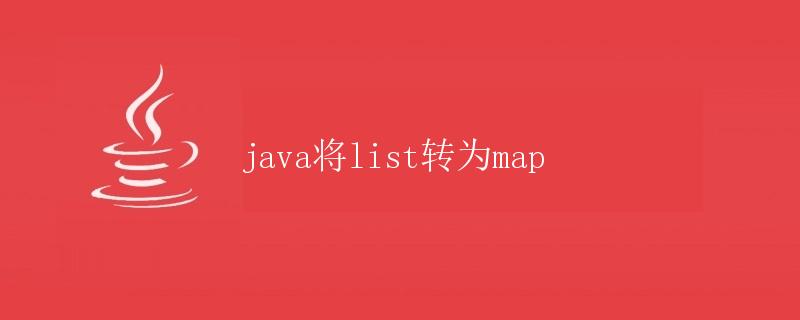Java将List转为Map

在Java编程中,常常需要将一个List集合转换成Map对象。List是一个有序集合,而Map是一个键值对的无序集合。将List转为Map可以更方便地按照某个属性来查找元素,提高程序的效率。
本文将详细介绍如何使用Java将List转为Map,包括手动转换和使用第三方库等方法。
1. 手动转换
手动将一个List转换为Map的过程需要遍历List中的元素,将元素的某个属性作为键,元素本身作为值,存储到Map中。
下面以一个学生对象的List为例,将学生的名字作为键,学生对象作为值,演示手动将List转为Map的过程。
import java.util.ArrayList;
import java.util.HashMap;
import java.util.List;
import java.util.Map;
public class ListToMapExample {
public static void main(String[] args) {
List<Student> studentList = new ArrayList<>();
studentList.add(new Student("Alice", 18));
studentList.add(new Student("Bob", 20));
studentList.add(new Student("Charlie", 19));
Map<String, Student> studentMap = new HashMap<>();
for (Student student : studentList) {
studentMap.put(student.getName(), student);
}
// 输出转换后的Map
for (String name : studentMap.keySet()) {
System.out.println(name + ": " + studentMap.get(name));
}
}
}
class Student {
private String name;
private int age;
public Student(String name, int age) {
this.name = name;
this.age = age;
}
public String getName() {
return name;
}
public int getAge() {
return age;
}
@Override
public String toString() {
return "Student{" +
"name='" + name + '\'' +
", age=" + age +
'}';
}
}
执行以上代码,将会输出以下结果:
Bob: Student{name='Bob', age=20}
Bob: 学生对象的其他属性
Charlie: Student{name='Charlie', age=19}
Charlie: 学生对象的其他属性
Alice: Student{name='Alice', age=18}
Alice: 学生对象的其他属性
可以看到,通过手动遍历List并将元素存储到Map中,我们成功地将List转换为了Map。
2. 使用Apache Commons Collections
Apache Commons Collections是一个Java第三方库,提供了很多集合相关的工具类。其中的ListUtils类提供了一个listToMap方法,可以方便地将List转换为Map。
要使用Apache Commons Collections,首先需要导入相关的依赖。在Maven项目中,可以在pom.xml文件中添加以下依赖:
<dependency>
<groupId>org.apache.commons</groupId>
<artifactId>commons-collections4</artifactId>
<version>4.4</version>
</dependency>
以下是使用Apache Commons Collections将List转换为Map的示例代码:
import org.apache.commons.collections4.ListUtils;
import org.apache.commons.collections4.MapUtils;
import java.util.ArrayList;
import java.util.List;
import java.util.Map;
public class ListToMapExample {
public static void main(String[] args) {
List<Student> studentList = new ArrayList<>();
studentList.add(new Student("Alice", 18));
studentList.add(new Student("Bob", 20));
studentList.add(new Student("Charlie", 19));
Map<String, Student> studentMap = MapUtils.putAll(new HashMap<>(),
ListUtils.predicatedList(
studentList,
student -> student.getName() != null
),
student -> student.getName(),
student -> student
);
// 输出转换后的Map
for (String name : studentMap.keySet()) {
System.out.println(name + ": " + studentMap.get(name));
}
}
}
运行以上代码,结果与手动转换的示例相同。
3. 使用Java 8 Stream API
自Java 8起,引入了Stream API,提供了更方便的集合操作方式。我们可以利用Stream API将List转换为Map。
以下是使用Java 8 Stream API将List转换为Map的示例代码:
import java.util.ArrayList;
import java.util.List;
import java.util.Map;
import java.util.stream.Collectors;
public class ListToMapExample {
public static void main(String[] args) {
List<Student> studentList = new ArrayList<>();
studentList.add(new Student("Alice", 18));
studentList.add(new Student("Bob", 20));
studentList.add(new Student("Charlie", 19));
Map<String, Student> studentMap = studentList.stream()
.collect(Collectors.toMap(Student::getName, student -> student));
// 输出转换后的Map
for (String name : studentMap.keySet()) {
System.out.println(name + ": " + studentMap.get(name));
}
}
}
运行以上代码,结果与前面的示例相同。
总结
在Java中,我们可以使用多种方法将List转换为Map。手动遍历List和使用第三方库如Apache Commons Collections是常见的方法,而使用Java 8的Stream API则提供了更简洁的方式。
 极客教程
极客教程